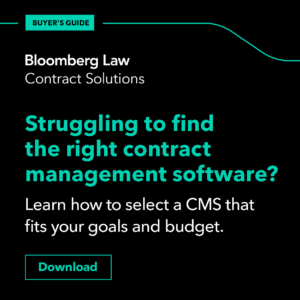 As of the time I’m writing this article, there are less than three weeks left until the end of the third quarter of 2021. Yikes! It. Is. Crunch time.
As of the time I’m writing this article, there are less than three weeks left until the end of the third quarter of 2021. Yikes! It. Is. Crunch time.
Quarter-end an be a hectic time for contracts professionals on both the sales and procurement side because of the high pressure to close a high volume of contracts in a short amount of time. These deadlines are tied to an organization’s revenue recognition or budget spend requirements. So the internal business teams are extremely motivated to get contracts closed. However, contracts professionals still need to go through the regular contract review process before approving a contract for execution. So the pressure is ON. How can we close more contracts before quarter-end?
Every minute you have needs to go towards closing as many contracts as possible before the clock runs out. So what can you do over the next three weeks to ensure that you successfully meet your quarter-end contract deadlines? Follow these best practices to help you close more contracts before quarter-end.
Plan & Prioritize
First, you need a plan. Review the contracts currently in your queue and use your best judgment (and contracts data, if any) to estimate how many new contracts might be submitted between now and then. This gives you a bird’s eye overview of your contracts goals and will help you plan resource and time allocation.
By Due Date
Then, prioritize your time. Focus on contracts that need to be executed before quarter-end. You will surely have contracts in your queue that are not. Communicate to your internal business clients that you need to focus on meeting quarter-end deadlines for the next three weeks and will resume their contract immediately after that. Be sure to reach out though and don’t just leave them hanging. For example, you can say something like, “I just saw that you submitted an NDA for review. As you can imagine, we are in crunch time with some high priority contracts that need to be closed by the end of this month. Does this need to be completed before quarter-end? If not, I can circle back with you on the first of the month.” This type of transparency and prioritization will foster better trust with your clients in the long-run.
For the contracts that are due before quarter-end, it is time to hit the ground running. You should opt for phone over email wherever possible to help speed up the review and negotiation process. If you haven’t already, schedule a meeting with the business owner of each contract to level-set on expectations, roles, and dependencies. Together, come up with an action plan to close the contract by quarter-end. Discuss things like:
- Internal and commercial negotiations, approvals, and dependencies (like compliance or data security reviews)
- External legal negotiations and redlines
- High risk items or high priority goals
- Contract signatory
By Complexity
Once you’ve aligned with your respective internal business clients, review your queue again and organize contracts by level of priority based on complexity.
- Contracts with red flags should be higher up on your list and tackled first. Red flags include high dollar value deals, high profile deals, and complex deals.
- Contracts that have not been started yet should be higher up on your list than contracts that are nearing the end of the review cycle. This should of course be balanced with the above point.
- For contracts with a low dollar value or low risk profile, try to focus on limiting the number of redlines rather trying to get every single revision you want. Discuss what’s important to your business client, advise them of the risks, and then determine which changes to push for versus which ones to accept as-is.
- When you receive a last-minute request for a contract (and you will) that is due by quarter-end, ask why and validate the necessity of the deadline. Rushed contracts are bad for business, but also inevitable.
Say No
In addition to prioritizing your time spent reviewing contracts, you should work on prioritizing your time altogether. It is very important that you say no to low or medium priority meetings, projects, emails, and requests that are not related to or dependent on a quarter-end deadline. You can always get to those next month. For example, you can say something like, “Can we reschedule this meeting to the beginning of next month? I really want to connect with you about this project but I’m afraid I won’t be able to give it the attention it deserves right now because of quarter-end.”
Run Your Redlines, Don’t Just Walk Them
Run your redlines as efficiently as possible by applying the 10 Rules of Contract Redlining Etiquette. This will ensure that you don’t waste a single minute (or redline) on unnecessary points. Your focus should be on doing everything you can to move the negotiation forward at every step. While eliminating lulls, managing your counterparty’s and your response times, and avoiding setbacks or causing friction.
Ask for Help
Meeting quarter-end contract deadlines isn’t just about you and your performance goals. It should be about hitting the overall organization’s goals. If you find yourself falling behind, you should be able to reach out to your boss or co-workers to ask for help. Maybe someone else has a lesser load and can help you out. Perhaps your boss can help re-assign a few contracts in your queue to an outside resource. Remember, you should be doing everything you can to support the business in meeting important deadlines.
Work Hard
There is no way to avoid the work. No matter how efficient your processes are or how automated your system is, at the end of the day, nothing will replace the analytical work that you need to contribute to successfully negotiate and finalize contracts. Do your best to apply the best practices mentioned above and get ready to double-down if necessary.
Identify Problems to Solve for Next Quarter-End
Over the next few weeks, jot down problem areas so that you can come back to them later. Keep track of specific use cases that will help demonstrate the problem areas. At the beginning of the new quarter, review your list with your boss or executive team so that you can work on improving your quarter-end experience the next time around.
* * *
When approaching quarter-end, your focus should be on hitting your contract deadlines. While there’s always going to be room for improvement and competing priorities, the final hour requires us to focus in on contracts and double down for the next few weeks. During this time, apply the best practices described above to close as many contracts as possible.















